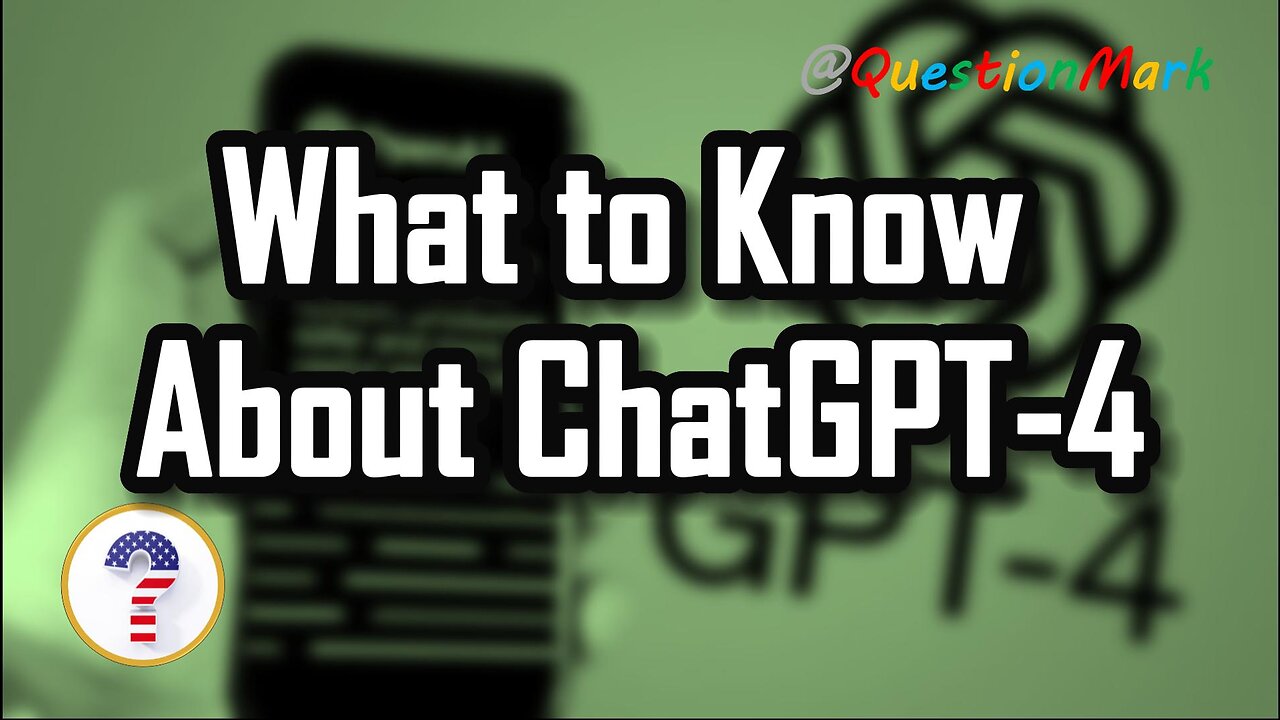Premium Only Content

What to Know About ChatGPT-4
It's been a mere four months since artificial intelligence company OpenAI unleashed ChatGPT and — not to overstate its importance — changed the world forever. In just 15 short weeks, it has sparked doomsday predictions in global job markets, disrupted education systems and drawn millions of users, from big banks to app developers.
But now it's goodbye to ChatGPT and hello ChatGPT-4 — an even more powerful tool, sure to send even bigger ripples across the world. So what is GPT-4, how powerful is it, and how can you use it? Here are 7 things you need to know:
1. What is ChatGPT-4?
Let's start with the name. The Chat section speaks for itself — a computer interface you can interact with — while GPT-4 is short for “generative pretrained transformer 4.” That means it's the fourth iteration of the OpenAI software that has analyzed vast quantities of information from across the internet in order to determine how to generate human-sounding text and give users detailed responses to questions.
2. How does ChatGPT-4 differ to its predecessor?
Anyone who has researched ChatGPT will know its limitations. It's been criticized for giving inaccurate answers, showing bias and for bad behavior — circumventing its own baked-in guardrails to spew out answers it's not supposed to be able to give.
The argument has been that the bot is only as good as the information it was trained on. OpenAI says it has spent the past six months making the new software safer. It claims ChatGPT-4 is more accurate, creative and collaborative than the previous iteration, ChatGPT-3.5, and "40% more likely" to produce factual responses.
3. What else can it do?
One of ChatGPT-4's most dazzling new features is the ability to handle not only words, but pictures too, in what is being called "multimoda" technology. A user will have the ability to submit a picture alongside text — both of which ChatGPT-4 will be able to process and discuss. The ability to input video is also on the horizon.
4. What are its limitations?
Like its predecessor, ChatGPT-4 isn't too hot at reasoning on current events, given that it was trained on data that existed before 2021. OpenAI said in a blog post that the latest iteration"still has many known limitations that we are working to address, such as social biases, hallucinations, and adversarial prompts."
5. How can I use ChatGPT-4?
Most people can give basic ChatGPT a whirl by signing up with OpenAI here, although restrictions apply in some countries and territories around the world. But the newest version is currently only being offered to ChatGPT Plus subscribers for $20 a month — sign up here — and as an API tool for developers to build into their applications. You can join the waitlist here.
In the future, you'll likely find it on Microsoft's search engine, Bing. Currently, if you go to the Bing webpage and hit the "chat" button at the top, you'll likely be redirected to a page asking you to sign up to a waitlist, with access being rolled out to users gradually.
6. Who is using ChatGPT-4 right now?
Morgan Stanley is using it to organize wealth management data, payment company Stripe Inc. is testing to see whether it can help combat fraud, and language-learning app Duolingo is incorporating it to explain mistakes and to allow users to practice real-world conversation.
7. What comes next?
In short, competitors. While Microsoft Corp. has pledged to pour $10 billion into OpenAI, other tech firms are hustling for a piece of the action. Alphabet Inc.'s Google has already unleashed its own AI service, called Bard, to testers, while a slew of startups are chasing the AI train. In China, Baidu Inc. is about to unveil its own bot, Ernie, while Meituan, Alibaba and a host of smaller names are also joining the fray.
-
 5:43:44
5:43:44
Scammer Payback
2 days agoCalling Scammers Live
99.9K17 -
 18:38
18:38
VSiNLive
1 day agoProfessional Gambler Steve Fezzik LOVES this UNDERVALUED Point Spread!
79K10 -
 LIVE
LIVE
Right Side Broadcasting Network
10 days agoLIVE REPLAY: President Donald J. Trump Keynotes TPUSA’s AmFest 2024 Conference - 12/22/24
8,327 watching -
 4:31
4:31
CoachTY
18 hours ago $14.69 earnedCOINBASE AND DESCI !!!!
65.5K8 -
 10:02
10:02
MichaelBisping
17 hours agoBISPING: "Was FURY ROBBED?!" | Oleksandr Usyk vs Tyson Fury 2 INSTANT REACTION
27.8K8 -
 8:08
8:08
Guns & Gadgets 2nd Amendment News
2 days ago16 States Join Forces To Sue Firearm Manufacturers Out of Business - 1st Target = GLOCK
72.3K64 -
 10:17
10:17
Dermatologist Dr. Dustin Portela
2 days ago $16.41 earnedOlay Cleansing Melts: Dermatologist's Honest Review
116K6 -
 1:02:20
1:02:20
Trumpet Daily
2 days ago $36.49 earnedObama’s Fake World Comes Crashing Down - Trumpet Daily | Dec. 20, 2024
74.9K51 -
 6:29
6:29
BIG NEM
1 day agoCultivating God Mode: Ancient Taoist NoFap Practices
56K9 -
 30:53
30:53
Uncommon Sense In Current Times
2 days ago $10.09 earned"Pardon or Peril? How Biden’s Clemency Actions Could Backfire"
71.9K5